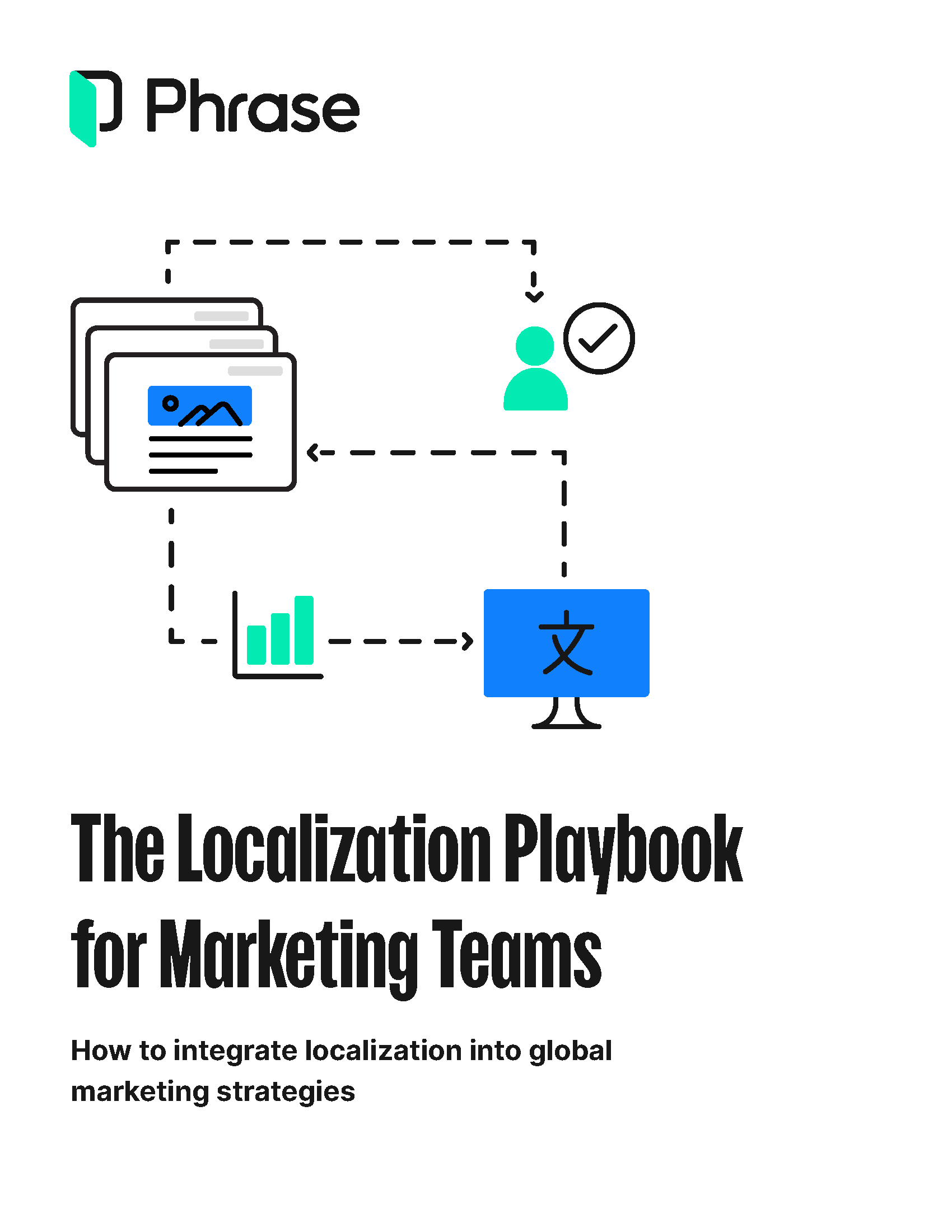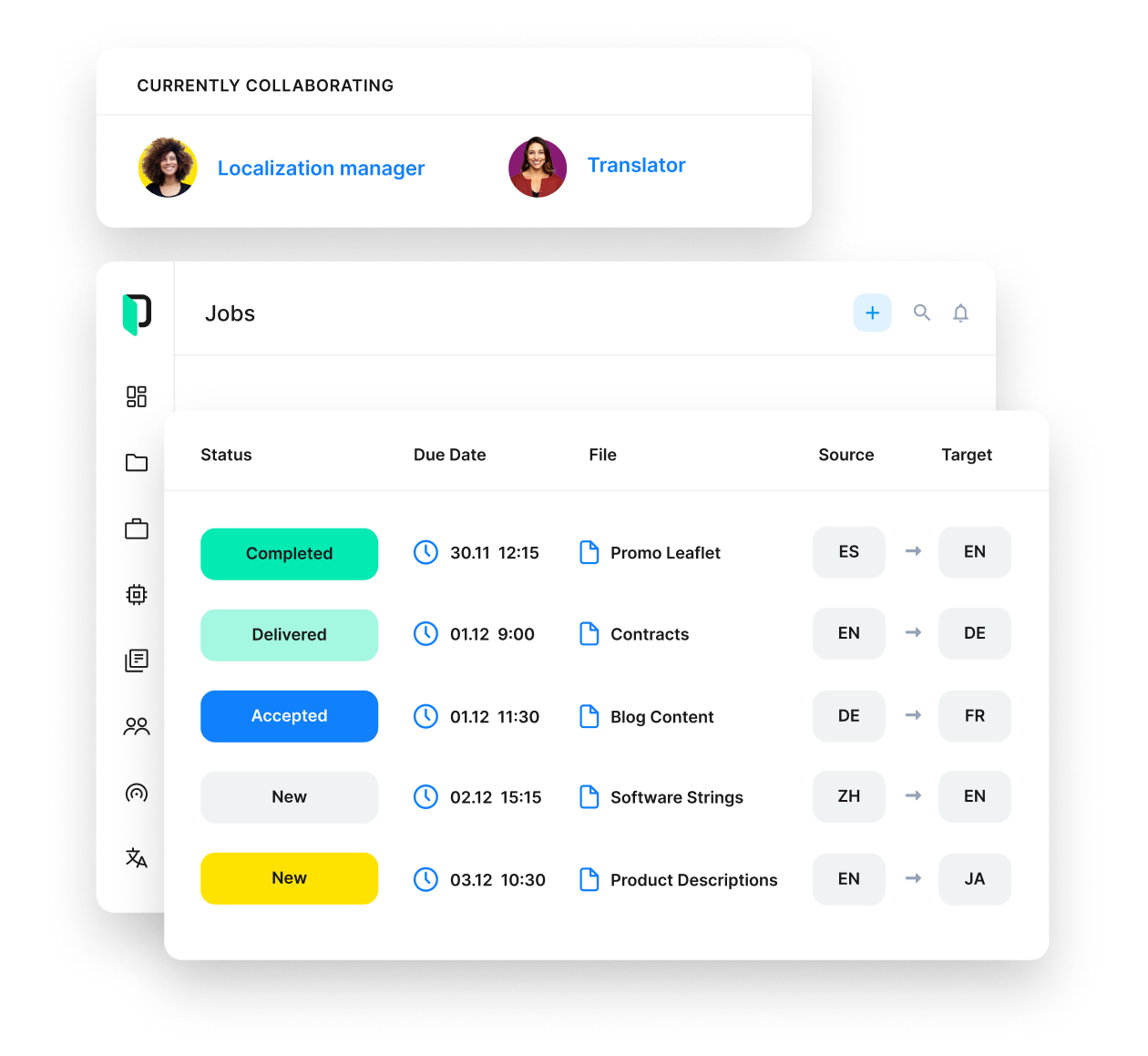Localization strategy
Marketing Localization: A Guide to Connecting with International Audiences

Global brands can reap enormous benefits from tapping into local preferences when crafting marketing campaigns. Coca-Cola’s 2011 Share a Coke campaign, for example, adapted bottle labels to include popular local names in each of the 70 countries where it was launched. It resonated so well with local audiences that US sales saw a 2% rise after a whole decade of decline.
The success of campaigns like Coca-Cola’s rests on the ability to make an impact in multiple markets and languages simultaneously. Marketing localization can be a powerful tool for accomplishing this. By adapting marketing strategies and materials to suit the preferences of customers across cultures, you’re able to connect with local audiences emotionally, drive engagement, and ultimately increase conversions.
Learn how to seamlessly integrate localization into your global marketing strategy and get the most out of your campaigns in each target market with this comprehensive guide.
What is marketing localization?
Marketing localization is the process of customizing content for specific markets by translating it into the local language and ensuring cultural relevance.
Marketing localization covers all issues that marketing managers need to resolve to create a marketing plan that’s tailored to the specific cultural context of each target market. Beyond language, marketing localization entails tailoring marketing to local customs, etiquette, values, consumer behavior patterns, and norms.
As a key part of any global marketing strategy, marketing localization helps brands create an emotional connection, drive engagement, and increase sales across markets. This process may include adapting messaging, promotion channels, or even the product portfolio and business model to suit the language or cultural preferences of a target market.
For example, Lay’s potato chips—originally from the US—are sold as “Walkers,” “Smiths,” “Sabritas,” or “Margarita” in different parts of the world. What’s fascinating is that Lay’s flavors not only vary across regions in the US but also internationally, reflecting the popular local foods of each country.
Regardless of how far Lay’s goes in adapting a name or flavor to the local context, it always remains true to its global brand identity. This commitment ensures recognition across cultures and languages. By maintaining global brand consistency, Lay’s effectively communicates its values and offerings worldwide, resulting in a stronger brand presence and improved customer engagement.
Key elements of successful marketing localization
A successful marketing localization plan involves several essential components that work together to create a personalized and engaging experience for diverse target audiences.
Website localization and local SEO for strong brand awareness
A global website is often the first point of interaction between a brand and the target audience. Therefore, it’s essential to ensure that the website content is translated accurately for every visitor to understand what a brand stands for and how its products can make their lives better.
Apart from language translation, a business should also consider adapting the style and tone of its website to align with the cultural nuances of its target market. This includes conducting research on the search behaviors of online users in search engines and fulfilling local SEO requirements.
Adapting promotional emails for higher conversion
Email marketing is a powerful tool for building relationships with your target audience. However, to be effective, your email messaging must resonate with local recipients from the start. This involves adapting your email marketing campaigns to reflect the culture and values of your target market.
Personalization is key to successful email marketing. If you address your potential customer by their name and speak to their interests, you can create a personalized experience that builds trust and rapport. Customers are more likely to respond positively to emails that relate to their preferences and needs.
Creating blog posts for locally relevant narratives
Your blog is an excellent opportunity to provide value to your target audience, demonstrate your expertise, build trust, and create engagement. To make the most of multilingual content marketing, your blog should share knowledge and stories that all tie back to a locally relevant narrative.
In other words, providing insights into industry-specific topics in a way that is relevant and relatable to the local market increases the odds of user engagement. This involves understanding your audience’s preferences, from the content format to the tone of voice.
Localizing advertising copy for maximum impact
Your advertising copy must get your message across effectively while resonating with your potential customers. When you localize your ads by choosing appropriate images, using relevant language, and making cultural references, you increase the chances of your audience connecting with your brand on a personal level.
By fine-tuning your ad copy to meet the needs of your local audience, you can create a powerful marketing message. Working with native-speaking copywriters or professional linguists experienced in transcreation can help you capture the essence of your brand in the respective language and convey your message in the most effective way possible.

FREE DOWNLOAD
Make global marketing strategies work in local markets
Harness the power of localization to effectively connect with audiences worldwide and discover best practices for making your next global marketing endeavor a success.
Marketing localization examples that made history—the good and the bad
When seeking inspiration from global marketing examples, it’s beneficial to analyze both successful, localization-aware campaigns and those that have failed. This can help you gain valuable insights and learn from both the triumphs and pitfalls. Let’s explore a few examples of each category.
Good: Mercedes-Benz
Originally Daimler-Motoren-Gesellschaft (DMG), this car manufacturing company was renamed Daimler-Benz in 1926 when Gottlieb Daimler and Karl Benz (from Benz & Cie.) signed the agreement for the merger of the two oldest automobile manufacturers in the world.
Both men had been designing and selling cars since the 1880s, with Emil Jellinek, an entrepreneur and racing enthusiast, as their largest dealer for DMG vehicles.
After Gottlieb Daimler passed away, Jellinek went on to help create the Mercedes 35hp in 1900. Jellinek named the new cars after his daughter, Mercédès Jellinek.The company registered the wordmark “Mercedes-Benz” as a trademark in 1925. While the company continued to trade as Daimler-Benz until 2022, the car line began to carry the Mercedes-Benz name. Jellinek suspected that the German-sounding “Daimler” would not sell well in foreign markets—a strong localization example that we can still learn from almost a century later.
Image © Mercedes-Benz Group AG
Bad: BMW
In 2016, BMW had to withdraw an international automotive marketing campaign from the United Arab Emirates because of local complaints about the use of the country’s national anthem in the commercial.
The commercial opened with players of a local football team signing the UAE’s national anthem but stopping halfway to rush out of the stadium into a fleet of BMWs.
Locally, the ad sparked complaints that it was disrespectful to the national anthem because it implied that the cars were more important than the anthem.
A hashtag meaning “suspend BMW ads” began trending on Twitter, which was enough for BMW to stop airing the commercial locally until they could re-edit it with a different soundtrack.
النشيد الوطني أسمى من أن يُساء له .. الإساءه تلحق صاحب فكرة الإعلان ومن وافق عليه وارتضى تنفيذه
— أسامة الأميري🇦🇪 (@OsAmiri) May 31, 2016
“The national anthem is bigger than the people who have disrespected it. The real people who have disrespected themselves are the people who conceived of the concept, agreed to it and then made it a reality.”
Good: Coca Cola
Coca-Cola’s 2011 “Share a Coke” campaign was arguably an unprecedented success in the global marketing business.
The disruptive yet simple idea of showing people’s names on Coke bottles and cans started in the United States. It was an emotional campaign that focused on connecting with consumers through their names.
The campaign’s emotional appeal was such that Coca-Cola built massive awareness and engagement with consumers around the world while simultaneously skyrocketing sales. That summer, Coke sold more than 250 million named bottles and cans in a country of 23 million people.
When it came to taking the idea globally to more than 70 countries, marketing teams from each market were allowed to put their own creative spin on the concept, while preserving the core idea of personalized Coca-Cola bottles and cans. They had to localize the names that would be displayed so that people across the globe could relate to them.
These localized versions not only increased local relevance but also provided an opportunity for deepened engagement with consumers. The campaign was a huge success in all markets, from big cities to small towns, without ever losing its local feel or core message.
Without a proper localization strategy in place to support such a massive global marketing endeavor, Coca-Cola could have wasted millions of dollars on a failed campaign.
Bad: Dolce & Gabbana
In 2018, Dolce & Gabbana faced enormous backlash after a series of short ads was released in China stereotyping Chinese people.
The controversial ads featured a Chinese model dressed in a lavish Dolce & Gabbana dress trying to eat pizza with chopsticks while a male voiceover condescendingly gives her instructions to be able to eat.
The ads were met with outrage by some members of the Chinese community. A Weibo (Chinese social network) user commented: “That’s explicit racism.” There were even calls to boycott the brand.
With Chinese consumers making up a third of the global luxury market, Dolce & Gabbana seems to have completely missed the mark with these ads. A localization strategy that took cultural sensitivities into account would have helped them avoid this pitfall.
Good: Absolut
Let’s now look at Absolut Vodka’s #SexResponsibly campaign. The global brand is renowned for its position at the cultural vanguard—in the US. It addressed the fact that an American is sexually assaulted every 68 seconds (as reported by the Rape, Abuse and Incest National Network) with perpetrators often using alcohol as both a tool and an excuse to commit their crimes.
On Valentine’s Day 2020, Absolut and Pernod Ricard USA launched the campaign “Drink Responsibly. #SexResponsibly” in an effort to drive real change in the way people perceive the connection between responsible drinking and consensual sex.

Image © Absolut
What made this campaign so successful in the US was that it focused on a local issue. If Absolut hadn’t localized this campaign to the US at the right time, when conversations around sexual assault were dominating national media, it probably wouldn’t have generated so much awareness for its brand and would have likely failed to create an impact in a key market.
Marketing localization challenges: Why some global campaigns fall flat in local markets
Based on the marketing localization examples discussed earlier, failed global marketing projects can generally be attributed to the following reasons:
- Insufficient or neglected local market research
- Misinterpretation of global campaign briefs or brand strategies
- Poor alignment between processes, resources, and tools
Insufficient or neglected local market research
One of the most common reasons for failed global marketing efforts is that the campaign creators don’t build in enough time to conduct thorough market research before crafting a global campaign.
Campaign creators sometimes neglect to incorporate consumer opinion gathering into the planning phase of their projects. They often fail to spend enough time determining how to localize their message for each global market.
The lack of analysis and consumer market immersion can hamper marketers’ ability to fully understand local consumers’ motivations and needs, which in turn translates into a lackluster, culturally irrelevant global marketing campaign.
Misinterpretation of global campaign briefs or brand strategies
In some cases, a failed global marketing effort can be attributed to a lack of understanding at the local level regarding the campaign’s objectives and the global brand strategy.
For example, if the global brand strategy emphasizes the product’s ease of use, but regional marketers are convinced that local market consumers prioritize affordability, a misalignment between the 2 perspectives can lead to a misguided campaign that falls short of expectations.
To prevent this, marketers must ensure clear brand strategy communication across various levels. Even when marketers conduct thorough research, craft the appropriate message, and outline an execution plan, it’s crucial to effectively convey the strategy to each local team, ensuring alignment.
Poor alignment between processes, resources, and tools
Working on global marketing campaigns can be a complex task for any global enterprise, so marketers need to have the right processes and technology in place for the best possible outcome. Otherwise, the risk of a high margin for error increases, leading to inefficient and costly revisions.
For example, manually translating marketing content in spreadsheets can lead to slow and low-quality work, wasting time and money on costly revisions. Automating manual or repetitive translation tasks with cutting-edge localization technology can help you streamline the process and eliminate inefficiencies.
Top 5 best practices for marketing localization
By recognizing and addressing the challenges of marketing localization, marketers can ensure that their campaigns truly resonate with customers worldwide. The following steps can serve as a guide to undertaking successful marketing localization.
Put together a cross-functional marketing localization team
To get started, you first need to think about the stakeholders who should handle a process as complex as marketing localization. It’s recommendable to have a single team responsible for managing the global localization process. From planning and execution to post-campaign evaluation, this will ensure a cohesive stakeholder management.
The challenge for global marketers lies in striking the right balance between centralized control through headquarters and empowered local teams. The latter may have the know-how for localizing global campaigns but can also lack a full understanding of the big picture defined by the headquarters.
Considering that shortcoming, it’s key to build bridges between global counterparts, break down communication silos, and provide opportunities for global learning so everyone involved can take full advantage of existing expertise, resources, and technology.
In marketing localization projects, there are several key stakeholders involved:
- Localization managers oversee the entire process, from hiring translators to ensuring smooth communication and file delivery.
- Product managers provide strategic direction, leveraging their understanding of the international landscape.
- Developers and localization engineers handle technical aspects, offering support to linguists for accurate translations.
- Designers ensure a seamless user experience in the localized version.
- Translators play a vital role in putting words to paper in the target language.
- Localization testers act as proofreaders and reviewers, ensuring consistency and design integrity—their contributions are essential for successful global expansion.
Get to know your target markets and work with local market experts
For each global marketing campaign you launch, create a “fitness” scorecard around each individual campaign component that assesses its localization fit. The localization team should help you ensure that the scorecard is accurate and results are meaningful.
To make sure you’re getting the most out of your localization efforts in all markets, consider conducting regular customer interviews and using the feedback to continually adjust campaign components. Carry out regular post-campaign evaluations of what worked and what didn’t so that you can apply your learnings to future campaigns.
All stakeholders you work with should have in-depth knowledge of both your product and the market you’re localizing for. Your team needs to understand the local market and its specific demands in terms of marketing, design, and legislation. This is the only way they can craft a user-friendly product.
When localizing for the Chinese market, for example, you need to take extra care not only with translations and marketing. China also has many tricky rules when it comes to coding, choosing the right local servers, and respecting the laws of the Great Firewall (GFW).
That said, defining an international buyer persona is no longer enough if you truly want to know what customers really want. Instead, you’d need to build local buyer personas, i.e. “local profiles” for each country you’re localizing for. You need to find out beforehand who you’ll be dealing with in any of those markets. Think about age, gender, relationship status, interests, education level, where they live, how much they earn, and what their purchasing habits are like. These answers will likely vary with each new country you’re approaching but are crucial for your success in localization, reducing both time to launch and costs.
Prioritize the content types for each target market based on their return on investment
When getting ready for marketing localization, you also need to think about what content you’re going to use. Having strong marketing content that’s easy to localize is essential when you’re looking to capture market share—as it will help you build brand awareness.
It’s not just about sending a message in the right language but also reaching real people using a voice your potential customers can understand. The best strategy is usually a mix of translated and localized content. How much to translate will depend on the revenue potential and cost-efficiency considerations.
Analyze each market individually and decide based on their specific characteristics. Translating English content into other European languages might help, but this strategy can hardly pay off in China. People there have almost no interest in products that aren’t directly related to their country.
Speed up delivery by leveraging machine translation for suitable content types
The use of machine translation (MT) in marketing sparks debate among marketers and linguists. Some value its speed and cost-effectiveness, while others see it as a necessary evil or an overrated shortcut.
MT can be useful for quickly translating low-impact content, but for high-visibility or sensitive material requiring accuracy, creativity, or craftsmanship, it’s best to stick to human translation.
For optimal outcomes, let’s examine 3 key content types and identify the most effective translation method.
Raw machine translation: To be used with caution
For low-impact, low-visibility, low-traffic, and unambiguous content, you can normally get away with using machine translation output that doesn’t undergo human revision. This is known as raw machine translation and is best suited for content such as:
- Internal documentation
- Website footers
- Social media posts compiled internally for sentiment analysis
- Repetitive technical content that doesn’t need to be 100% accurate, just actionable, like instruction manuals
- User-generated content like product reviews, for which consumers generally expect low quality
- Chat or email support messages
Raw MT will benefit your marketing localization efforts only as long as you use the best-performing machine translation engine for your language pair and content.
Post-edited machine translation: The middle ground
There are times when content is more sensitive than what you’d want to put through raw MT, but it’s not so critical that you want to spend the time and money to get a human translator involved. In these cases, machine translation post-editing (MTPE) can be helpful.
MTPE entails a human translator cleaning up the machine translation output to make it more accurate and idiomatic. Some examples of content suitable for MTPE in marketing localization are:
- Ecommerce product titles
- Product descriptions
- Knowledge bases
- Frequently asked questions (FAQs)
- Back-end SEO meta information such as image alt texts and captions
To maintain consistent brand voice and messaging across cultures, post-editors usually work with traditional translation tools like translation memories, termbases, glossaries, or style guides.
Modern translation technology makes it even possible to estimate the quality of machine translation output to concentrate post-editing resources where they’re most needed.
Human translation: For sensitive material
Every marketing campaign contains elements that relate closely to branding. These high-traffic, durable assets aimed at persuading, delighting, or reassuring the target audience—together with sensitive or confidential content—are best left in the hands of human experts:
- Homepages, landing pages, and high-visibility website UI
- Blog posts
- User-oriented newsletters
- Press releases
- Print and digital advertising
- SEO content
- Legal or contractual documentation
Automate manual or repetitive translation tasks with localization technology
With marketing localization involving multiple stakeholders, you can hardly afford bottlenecks, rework, and unnecessary delays. Those long email back-and-forths; the attached file that nobody is certain is the most updated version; the translation that’s sitting there waiting for marketing to sign off on a minor change—all of these can add up to a marketing campaign that’s late to market and/or over budget.
Yet, most common translation workflows still tend to be manual—and therefore extremely resource-intensive and time-consuming:
- The marketing team is copy-pasting content to a text document or spreadsheet
- The marketing or localization manager shares it with translators along with reference materials
- The translators are working on it and seeking clarification if needed
- The translator submit the completed work to the manager who then sends it for proofreading
- The manager approves the translated content and let’s the team integrate it into marketing channels
This workflow might have worked well enough in the past, but with the world becoming increasingly globalized and the need for marketing responsiveness ever more urgent, marketing teams require better marketing localization workflows that reduce the time campaigns take to translate and launch.
So what exactly should you aim for when automating localization? Consider using a translation management system, like Phrase TMS. A cloud-based TMS will enable you to centralize and standardize all of your processes, manage the creation and use of glossaries, control costs by adopting an efficient workflow, monitor performance with comprehensive reporting capabilities, and take advantage of a range of other features that are useful in managing a localization project.

Phrase TMS
The enterprise-ready translation management system
Work with the leading TMS to automate translation workflows with cost control and quality checks.
More specifically, a translation management system gives marketers the following main capabilities:
- Automation: Translatable content should be automatically extracted from content management systems, source code repositories, or marketing automation platforms and routed to the translation interface. Translated content should be able to be automatically imported back into the original environment.
- Centralization: Providing a single point of access to all relevant marketing materials, resources, instructions, and content increases productivity and reduces the chances of errors. Marketing and localization teams should be able to work from a single platform, with all the tools they need at their fingertips.
- Real-time collaboration: A TMS acts as a hub through which marketing teams can collaborate with other departments and both in-house and external stakeholders in real time, ensuring that everyone’s working from the most up-to-date content.
- Translation memory: A robust TMS lets you store translations in a cloud-based translation memory, which allows translators and marketing teams to reuse content across different marketing campaigns.
- Support for familiar file formats: No more copy-paste. You should be able to submit content for translation in your preferred file types: IDML, PSD, SVG, HTML, etc.
- Integration: The TMS should be able to quickly and easily integrate with content management systems (e.g., Marketo, HubSpot, Adobe Experience Manager, WordPress, Drupal, Contentful, Contentstack, Sitecore), ecommerce platforms, marketing automation platforms, and CRM systems, or even let you build a custom integration via a REST API.
- Quality control: The TMS should include a quality assurance process that facilitates checking translations for accuracy against previously translated content (through the use of translation memories), marketing brand guidelines, style guides, and glossaries.
- AI-powered machine translation: A modern TMS combines well-established translation technology with AI-powered machine translation capabilities.
- Tracking and reports: The best TMS will provide marketing teams with insights and reporting that can be used to improve marketing performance and marketing ROI and will let them monitor translators’ performance to make any necessary adjustments.
With technology firmly in place to support it, marketing localization efforts are nigh on unbeatable as a competitive advantage for any company seeking to succeed globally. A robust TMS helps marketing teams deliver higher quality work on time and on budget, which ultimately boosts marketing performance, increases sales, and boosts marketing localization ROI.
Successful marketing localization is an exercise in balance
When it comes to running successful global campaigns, marketers need to think about how to strike the right balance between:
- Leveraging existing assets and creating local content from scratch
- Staying true to global brand standards and catering to local preferences
- Working towards global company objectives and meeting local customer needs
- Saving budget where possible, for example, through MT, and investing in the right people and tools where necessary
At the end of the day, this balance is what connects the right people with the right processes by leveraging the right technology. This solid basis can help global marketers effectively launch campaigns that resonate with customers worldwide and motivate them to buy your product. The final result? Even greater global revenue growth in the long run.
Speak with an expert
Want to learn how our solutions can help you unlock global opportunity? We’d be happy to show you around the Phrase Localization Platform and answer any questions you may have.






